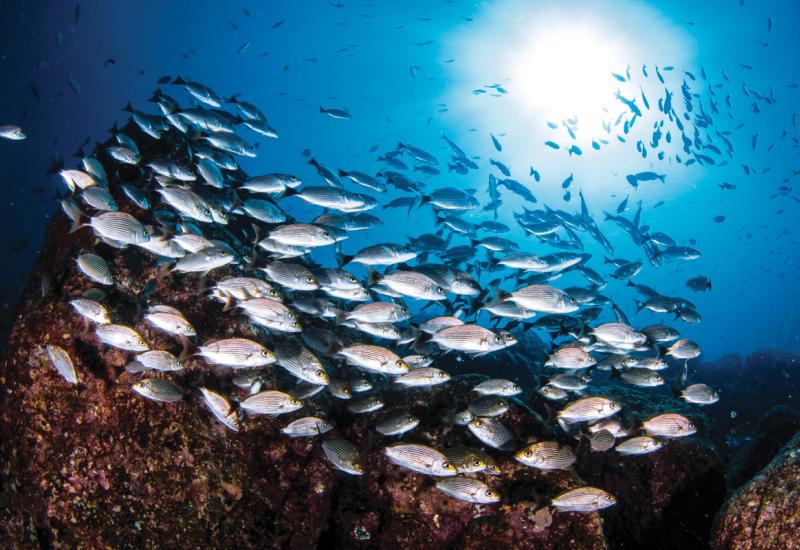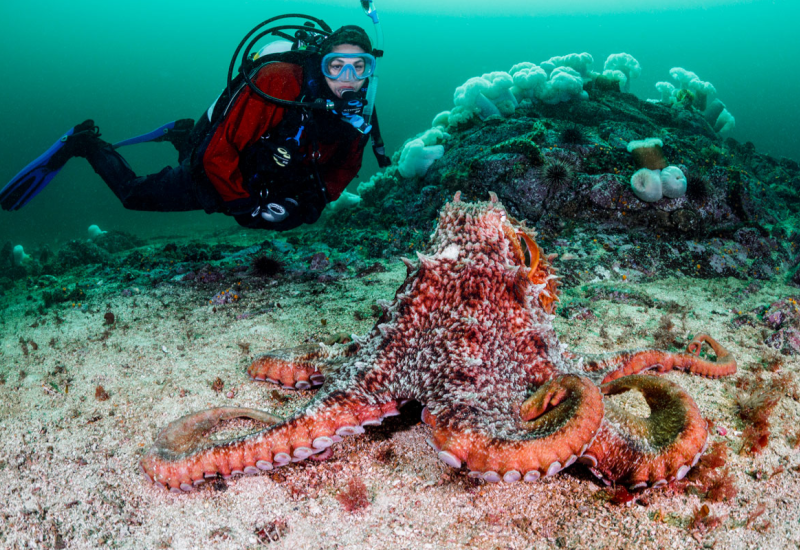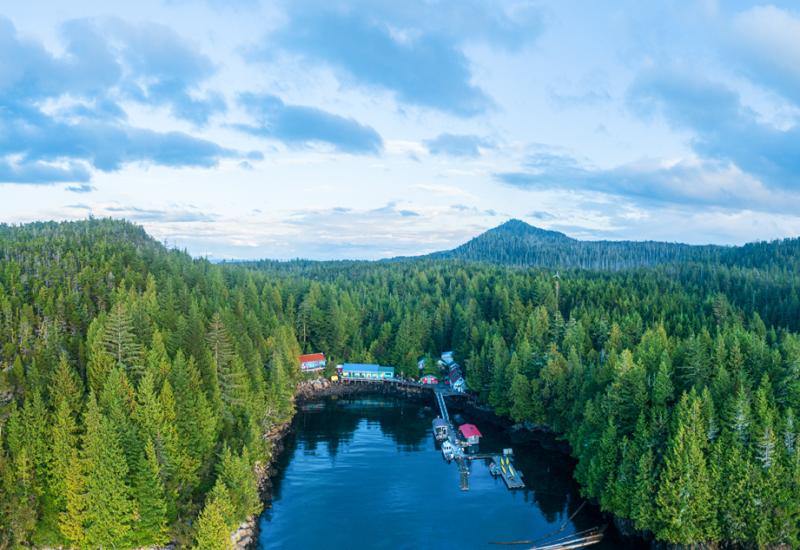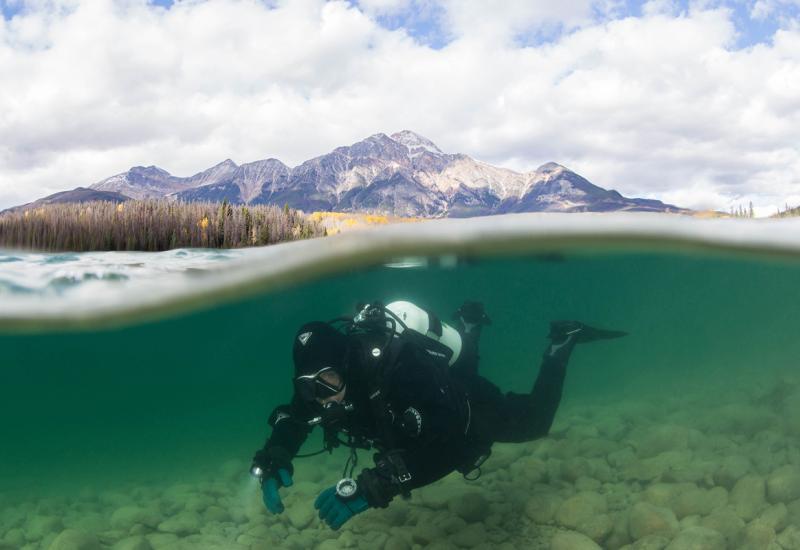Nanaimo

April 2002
By Michael LoVecchio
Three years, three minutes and 37 seconds. That's how long it took our volunteers from the Artificial Reef Society of British Columbia and the Nanaimo Dive Association to sink the HMCS Cape Breton, the world's largest (by tonnage) artificial reef for divers. Three years to secure the wreck, the site, the funding and to clean the vessel to Canada's rigorous safety and environmental standards. Then the cutting charges pierced the hull, and in mere minutes, the giant World War II Liberty ship sank beneath the surface. A week later, I was finally getting my chance to dive her. Cape Breton sits off Snake Island at the entrance to Departure Bay near Nanaimo, British Columbia. The ship began service measuring 441 feet long, 57 feet wide, and standing six decks tall. With her stern and engine removed for preservation, the ship now measures 411 feet, but she still displaces a whopping 10,100 tons.
As Ian Hall, head of the Nanaimo Dive Association, proceeded with a detailed briefing, I thought back to my last visit. The night before explosives were placed, I visited every compartment of the ship. I crawled through the prop-shaft tunnel where we scooped and vacuumed rust, grease, and 50 years of paint chips from its 160-foot length. I wandered the length of the ship's central passage along deck three, the "Burma Road," as it is known in Canadian naval tradition. I stood on the engine room floor and watched the stars through the skylights 80 feet above me.
Just 40 hours later, the charges went off and the ship began to sink--twice as fast as anticipated. We speculated that the hull might have been damaged when she hit bottom, and I couldn't wait to find out for sure. Descending a forward mooring buoy line, one of six attached to the ship, I watched the dark outline of the vessel come into focus. Visibility cleared to an impressive 80 feet and Cape Breton welcomed me back.
It was a sight to behold. The ship had submerged bow-first with a starboard list, but had settled square on her keel. My buddy and I dropped deep into the foundry, a basketball-court-sized compartment, 136 feet below the surface and were greeted by a surprise: The hull had split from the base on the port side along the foundry wall. Looking through the crack was like peering through a window onto the Emerald Sea.
There was another crack in the hull in the huge crew's quarters on deck three. The main deck had buckled, but not broken. It looked like someone pushed an area rug together with a large roll. There was no tear along the starboard side, but the hull was clearly bent off true. Yes, the impact had put major stress on the ship's hull, but Cape Breton was standing tall, upright and dive-ready.
On the short trip back to port, I enthused to Ian that the graceful damage to the hull added to the adventure. We shared a laugh thinking of the sea stories that would be invented about the Cape Breton's hull over the years to come. And I have been thinking about the next project ever since.
Dive Nanaimo
||
|---|
|

|
Location: Cape Breton sits 500 feet due south of the 366-foot destroyer escort Saskatchewannear Snake Island. Together, the ships create the world's largest artificial reef.
Water Conditions: Expect temperatures at depth to stay near 40F year-round. A dry suit is highly recommended. Visibility ranges from 40 to 100 feet, depending on seasons, and is typically best in autumn and winter. Expect minor surface currents, depending on winds and tides.
Profile: The ship sits in 141 feet of water, its upper decks beginning at 50 feet and its signals mast rising to 35 feet. Novice divers should tour the outer superstructure of the ship, which has three distinct deckhouses. Penetration, which should only be attempted by properly trained and equipped divers, is facilitated by four cargo shafts running from the main deck to the base of the ship and regularly spaced diver-access holes cut into the hull. The engine room cavity, situated mid-ship, is also accessible through overhead skylights.
Dive Operators: Nanaimo Dive Association at (250) 729-2675 or www.divebritishcolumbia.com; Ocean Explorers Diving at (800) 233-4145 or www.oceanexplorersdiving.com; Sundown Diving at (888) 773-3483 or www.sundowndiving.com; or Vancouver Island Dive Vacations at (250) 740-2590[.
For More Info: Tourism Nanaimo, (800) 663-7337 or ](http://www.vidive.com)www.tourismnanaimo.com. The Artificial Reef Society of British Columbia, www.artificialreef.bc.ca.

April 2002
By Michael LoVecchio
Three years, three minutes and 37 seconds. That's how long it took our volunteers from the Artificial Reef Society of British Columbia and the Nanaimo Dive Association to sink the HMCS Cape Breton, the world's largest (by tonnage) artificial reef for divers. Three years to secure the wreck, the site, the funding and to clean the vessel to Canada's rigorous safety and environmental standards. Then the cutting charges pierced the hull, and in mere minutes, the giant World War II Liberty ship sank beneath the surface. A week later, I was finally getting my chance to dive her. Cape Breton sits off Snake Island at the entrance to Departure Bay near Nanaimo, British Columbia. The ship began service measuring 441 feet long, 57 feet wide, and standing six decks tall. With her stern and engine removed for preservation, the ship now measures 411 feet, but she still displaces a whopping 10,100 tons.
As Ian Hall, head of the Nanaimo Dive Association, proceeded with a detailed briefing, I thought back to my last visit. The night before explosives were placed, I visited every compartment of the ship. I crawled through the prop-shaft tunnel where we scooped and vacuumed rust, grease, and 50 years of paint chips from its 160-foot length. I wandered the length of the ship's central passage along deck three, the "Burma Road," as it is known in Canadian naval tradition. I stood on the engine room floor and watched the stars through the skylights 80 feet above me.
Just 40 hours later, the charges went off and the ship began to sink--twice as fast as anticipated. We speculated that the hull might have been damaged when she hit bottom, and I couldn't wait to find out for sure. Descending a forward mooring buoy line, one of six attached to the ship, I watched the dark outline of the vessel come into focus. Visibility cleared to an impressive 80 feet and Cape Breton welcomed me back.
It was a sight to behold. The ship had submerged bow-first with a starboard list, but had settled square on her keel. My buddy and I dropped deep into the foundry, a basketball-court-sized compartment, 136 feet below the surface and were greeted by a surprise: The hull had split from the base on the port side along the foundry wall. Looking through the crack was like peering through a window onto the Emerald Sea.
There was another crack in the hull in the huge crew's quarters on deck three. The main deck had buckled, but not broken. It looked like someone pushed an area rug together with a large roll. There was no tear along the starboard side, but the hull was clearly bent off true. Yes, the impact had put major stress on the ship's hull, but Cape Breton was standing tall, upright and dive-ready.
On the short trip back to port, I enthused to Ian that the graceful damage to the hull added to the adventure. We shared a laugh thinking of the sea stories that would be invented about the Cape Breton's hull over the years to come. And I have been thinking about the next project ever since.
Dive Nanaimo
|| |---|
|
|
Water Conditions: Expect temperatures at depth to stay near 40F year-round. A dry suit is highly recommended. Visibility ranges from 40 to 100 feet, depending on seasons, and is typically best in autumn and winter. Expect minor surface currents, depending on winds and tides.
Profile: The ship sits in 141 feet of water, its upper decks beginning at 50 feet and its signals mast rising to 35 feet. Novice divers should tour the outer superstructure of the ship, which has three distinct deckhouses. Penetration, which should only be attempted by properly trained and equipped divers, is facilitated by four cargo shafts running from the main deck to the base of the ship and regularly spaced diver-access holes cut into the hull. The engine room cavity, situated mid-ship, is also accessible through overhead skylights.
Dive Operators: Nanaimo Dive Association at (250) 729-2675 or www.divebritishcolumbia.com; Ocean Explorers Diving at (800) 233-4145 or www.oceanexplorersdiving.com; Sundown Diving at (888) 773-3483 or www.sundowndiving.com; or Vancouver Island Dive Vacations at (250) 740-2590[.
For More Info: Tourism Nanaimo, (800) 663-7337 or ](http://www.vidive.com)www.tourismnanaimo.com. The Artificial Reef Society of British Columbia, www.artificialreef.bc.ca.










